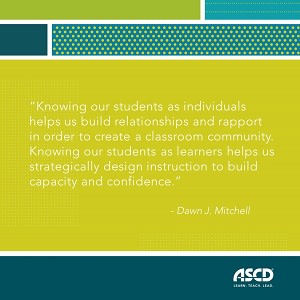To engage students and help them focus on prioritized standards and learning goals, we must ensure that hands-on projects aid them in developing and demonstrating the most important evidence of understanding.
Three Key Elements
Throughout the disruption of the pandemic, students and teachers lamented missing out on hands-on activities and group projects. This isn’t surprising: These opportunities give students authentic experiences that allow them to engage with classmates and apply important skills and understandings.
Designing projects that allow students to be engaged and demonstrate evidence of the most important skills and understanding from a unit of study requires alignment among three elements:
- The prioritized standard or learning goal.
- Standards-aligned success criteria.
- Observable, standards-based evidence from the project that can be described using the most important success criteria.
While we might assume that these elements should easily fall into alignment, the process is more challenging than it appears.
More Than Directions and Evidence of Compliance
When the standard, project, and success criteria are misaligned, projects can be cluttered and distract students from investing effort in deepening their understanding or demonstrating what they’ve learned. Consider the following scenario.
Eighth grade students are engaged in a six-week unit titled “Understanding Force and Motion.” The teacher has identified the following prioritized standard to guide work throughout the unit:
I can explain the form and function of simple machines in a variety of specific mechanical contexts as related to force, motion, mass, balance, friction, resistance, and energy.
During the final two weeks of the unit, the teacher designs a hands-on culminating project to give students a chance to show what they’ve learned. Students work in teams to design and build a Rube Goldberg device in which a steel marble must roll through a series of components until it flips a switch that causes a lever to ring a bell. Students are given a list of materials they can use, along with the following success criteria and grading scheme:
- Device uses two levers (5 points each; 5 additional points each if they work properly = 20 possible points)
- Device has at least 2 ramps (5 points each; 5 additional points each if they work properly = 20 possible points)
- Device takes more than five seconds from marble drop until the bell rings (10 points per second beyond 5 seconds = up to 60 possible points; no bell = no points)
After an entire week spent designing their devices, acquiring materials, and building them in class, the big day finally arrives. The teacher and students move from station to station as teams drop their marbles and set their devices in motion. Only one group’s device works perfectly and is given the maximum number of points. When the teacher asks those students to explain how their device worked, they look at one another for a few seconds before one of them replies, “Sam had a really heavy marble and we used a lot of duct tape.”
The teacher probes with a few more questions, but their answers solely revolve around materials, directions, and points.
Aligning Evidence, Standards, and Success Criteria
When the success criteria and grades are completely detached from the most important evidence of understanding, we unintentionally communicate a message to students that accomplishing the task—rather than developing and demonstrating evidence of understanding—is the main reason for engaging in the project. Given the investment in class time for projects and their fantastic potential to engage students, consider the following action steps to avoid the perils, and access the potential, of projects.
To avoid the perils of projects:
To avoid the perils of projects that don’t develop or demonstrate evidence of important skills and understanding, beware of the following traps.
- Don’t confuse following directions with evidence of understanding. Students always benefit from clear parameters when doing projects. They need limits in what resources should be used, how many pages are required in a final report, what tech tools should be used, or how long a presentation or video should be. However, these arbitrary elements of the project have little or nothing to do with evidence of understanding and, therefore, should not be in the success criteria. Articulate parameters in directions to make the workload and scope clear to students (and manageable for you to give feedback), but don’t accidentally develop assessments that merely provide evidence of whether or not students followed directions.
- Don’t assume more is better. Would you rather read a clear, concise paragraph that states and supports a claim with well-aligned evidence . . . or read five vague paragraphs? Or, if you could vote for the Academy Awards, would you cast your vote depending on which film was longest? “More” is rarely the discerning factor in determining the quality of one’s evidence of understanding. If your success criteria awards more points for more “stuff,” your students may sacrifice quality for quantity. Be sure success criteria focuses on evidence of quality and depth of understanding, not quantity as related to an arbitrary component of the task.
- Ask yourself this question: Given resources, directions, and time, could students have done this culminating project before the unit even started? This litmus test forces us to think about how the design of the task relates to evidence of understanding from that unit. Too often, projects require a lot of time, directions, materials, and effort, but the students don’t have to draw on the concepts, skills, and vocabulary that are the point of the unit in the first place. Consider the science example above: Any student who knew what a ramp, lever, and Rube Goldberg device was could have completed the project—even without any physics instruction from that unit.
To access the potential of projects:
To design hands-on, engaging projects that also help students develop and demonstrate understanding of the most important standards, consider the following.
- Begin by aligning prioritized standards to observable evidence of understanding. Read the priority standard for the unit and ask yourself, what evidence would I need to see from a student to know what the student understands? Focus on verbs in the standards such as compare, analyze, describe, design, evaluate, and justify. The task you design (make a poster, create a brochure, give a presentation, deliver a sales pitch) is not the destination; it is the bridge between the standard and the evidence of understanding.
- Ensure success criteria focus on the most important, transferable elements of the standards. For example, the success criteria in the Rube Goldberg scenario was more about an arbitrary set of expectations for designing a device than understanding force and motion. It could be revised to focus on identifying types of force in different parts of the Rube Goldberg device, explaining the movement of the ball using key vocabulary words from the unit, or articulating one’s understanding of the concepts in the unit to evaluate the design and hypothesize why the marble did, or did not, ring the bell.
- Ask kids to be metacognitive. Sometimes the evidence from the task tells us very little about the understanding that matters most. In the scenario above, does it really matter if the marble rings the bell? Or would it be more valuable to know a student’s answers to questions such as, “Using the words friction, momentum, and energy, explain how your device was designed to trip one of the levers on your device.” Or “Using vocabulary from this unit, explain why your marble did, or didn’t, ring the bell.” Asking questions like these forces us to think about how we can make the most important evidence observable, and help kids see the project as a catalyst for thinking more deeply about important skills and understandings, rather than thinking about following directions and accumulating points.
Hands-on, engaging learning experiences are an essential component of effective curriculum, instruction, and assessment. To tap into the potential of projects, design them so students are required to develop and demonstrate evidence of understanding of priority standards as aligned to the most important standards-based success criteria.
Related Resource
For more examples and action steps, check out Tony Frontier's ASCD summer release Teaching with Clarity: How to Prioritize and Do Less So Students Understand More.








